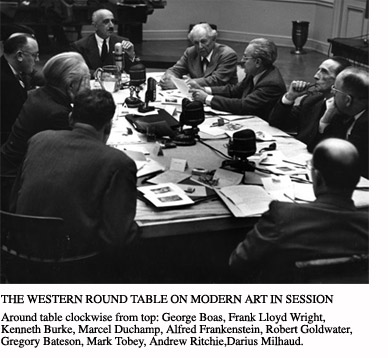
PARTICIPANTS
George Boas (Moderator):
Philosopher; Professor of History of Philosophy,
John Hopkins University; Trustee, Baltimore
Museum of Art.
Gregory Bateson: Cultural anthropologist,
Lecturer, Langley Porter Clinic of the University
of California Medical School; authority on Bali
and New Guinea.
Kenneth Burke: Literary Critic,
philosopher, novelist; Professor, Benning College,
Vermont.
Marcel Duchamp: Artist.
Alfred Frankenstein: Critic;
Music and Art Editor, San Francisco Chronicle.
Robert Goldwater: Critic and
Art Historian; Editor, Magazine of Art; Associate
Professor of Art, Queens College.
Darius Milhaud: Composer and
conductor; Professor of Composition, Mills College.
Andrew C. Richie: Art Historian and
critic; Director, Department of Painting and
Sculpture, Museum of Modern Art.
Arnold Schoenburg: Composer.
Mark Tobey: Artist.
Frank Lloyd Wright: Architect.
|
 |
(Note: Quotation
marks are used for all statements made directly
by members of the symposium. Sections cut from
a given statement are indicated by a row of
dots. Chronological gaps are shown by a separate
line of asterisks. Editorial paraphrases and
indirect quotations appear outside quotation
marks. Editorial observations are enclosed by
parentheses.) |
 |
|
The Western Round
Table on Modern Art met in San Francisco, April 8,
9 and 10, 1949.
The object of the Round Table was to bring
a representation of the best informed opinion of the
time to bear on questions about art today (1949).
A set of neat conclusions, as to the outcome of the
conference, was neither expected nor desired. Rather,
it was hoped that progress would be made in the exposure
of hidden assumptions, in the uprooting of obsolete
ideas, and in the framing of new questions.
Two quotations may emphasize this intention. Alfred
North Whitehead pointed out, in discussing the basic
assumptions by which we live, that ". . . assumptions
may appear so obvious that people do not know what
they are assuming because no other way of putting
things has ever occured to them."
Pursuing this statement, Suzanne Langer wrote
that "a philosophy is characterized more by the
formulation of its problems than by its solution of
them. Its answers established an edifice of facts;
but its questions make the frame in which its picture
of facts is plotted."
Judgement of what was said at the Round Table
is invited in terms of these general purposes.
Describing the meeting later, one of the participants
put it this way: "There in that room, were a
bunch of guys trying to think. We were most of us
prima donnas, and from time to time we stopped thinking
to try to pull off an epigram. But still––a
bunch of guys trying to think. Still more difficult,
we were trying to think aloud and trying to communicate
with each other––trying to get things
clear that have never been gotten clear."
THE PROCEEDINGS
Three sessions were scheduled for the first
two days; an unscheduled fourth session was added
the third day at the request of some participants.
The second session was open by invitation to the public
and to members of the San Francisco Art Association;
the three other sessions were closed.
All sessions were transcribed by two court reporters
and also recorded on wire. Conference time totaled
nine hours. The typed transcript was then corrected
and approved by each contributor.
Sets of photographic reproductions of works in this
exhibition were made in advance and sent to members
of the symposium for preparatory reference. During
the discussion, points were illustrated from time
to time by examples in the exhibition. At the onset,
however, it was decided that lengthy devotion to analysis
of specific works of art would emphasize individual
preference and idiosyncrasy at the expense of ideas
with the possibilities of wider and deeper implication.
A special exhibition of modern art was assembled for
the event and shown concurrently at the San Francisco
Museum of Art, where the meetings were held. A list
of works in the exhibition is appended to the abstract.
The Round Table and its Exhibition were organized
by Douglas MacAgy, then Director of the California
School of Fine Arts. |

